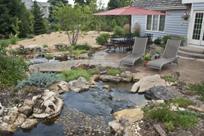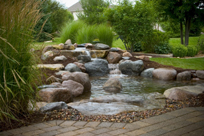The Right Moves

Building a pond is a relatively simple task – so much so that many people start the process without having given it enough thought.
The problems that arise from this hastiness are so common (and in some cases so devastating) that we at Aquascape now refer to them as the “Ten Blunders that Get in the Way of Pond Success.” Before putting spade to soil – and no matter whether this is your first pond or your fiftieth – run through this list and save yourself some trouble.
Poor Location: All too often, ponds are placed in an unused corner of a property or in a low spot that collects water. Neither spot is ideal: Unused corners of the landscape are unused for a reason, and it’s a waste to put a key feature where it won’t be seen and appreciated regularly. There’s also the “out of sight, out of mind” factor: If nobody sees the pond, it’s likely nobody will care for it. For their part, low spots might seem logical locations for ponds, but the opposite is true: They are challenging to build in because of the high water table, and water quality tends to suffer from too much runoff and pollution entering the pond system.
Inadequate Access: Here’s another “location” issue: Before work starts, it’s important to decide where rock and gravel will go when it’s delivered – and where you want to put the dirt produced by the excavation. Poor planning here can lead to all sorts of problems in moving around the site to get things done.
Underestimating Labor: It’s quite common to underestimate the amount of sheer physical work involved in pond installation. Quite often, in fact, professionals are called in to complete the work of do-it-yourselfers who’ve partially excavated their own watergardens. If you don’t dig for a living, this part of the projects is tougher than you think – and this is the easy part!
Excessively Small Size: A small pond may be easier to build (less digging, less work with heavy materials), but it will prove to be much harder to maintain successfully. This is because a small ecosystem is less stable than one with a larger volume of water (temperature swings alone can make small ponds a nightmare for fish and plants). And there’s also the fact that fish and plants grow, meaning that even if they survive, they’ll eventually need a bigger pond if they are to keep on thriving.
Overly Shallow Water: Again, a shallow pond may be easier to dig than a deeper one, but if the water isn’t deep enough, the fish won’t be able to over-winter where the weather gets cold and won’t be able to stay cool enough where the weather gets hot. Fish don’t fare well in temperature extremes, and shallow water invites both the lows and the highs.
Overly Steep Sides: Digging a deep pit and making no provisions for shallow areas is a common excavation error. Not only will the walls be unstable and subject to collapse, but the steepness also makes it difficult to stack stone on the inside of the pond. And then there’s a practical issue: If all approaches to the pond are deep and  steep, how will anyone be able to get in or out of the water to do routine maintenance? Also, most aquatic plants grow best in less than 12 inches of water, so where will they go if there aren’t any ledges or shelves?
steep, how will anyone be able to get in or out of the water to do routine maintenance? Also, most aquatic plants grow best in less than 12 inches of water, so where will they go if there aren’t any ledges or shelves?
Lack of Ledges: Right along with excessively steep slides are ponds dug with uniform bowl shapes in which all sides slope gently down to the middle. Not only will this lead to the same sort of trouble with plants mentioned just above, but it also makes it very difficult to “naturalize” the pond with rockwork. Gravel, for starters, will tend to migrate down the slope and toward the middle of the pond, while boulders will generally take up too much room.
Improper Use of Stone: Extending from that last point, ponds get their naturalistic appearance through the adept use and placement of stone – usually several tons of it in a project of any size. Do-it-yourselfers generally can’t manage that volume of material and compromise by using smaller, more manageable stones (if they use any sizeable stones at all!) – which might be easier but tends to sacrifice the aesthetic value imparted by substantial boulders. And it’s not all about looks: Without rock and gravel, the ecosystem will have a harder time of it because the surfaces of the stones serve as habitats for beneficial organisms that help keep the pond in balance.
Lack of Proper Filtration: It’s surprising how many prospective watergardeners think that backyard ponds are like natural lakes, rivers, streams and ponds and will function perfectly well without recirculating pumps and filters. It’s also surprising among those who are wise enough to perceive the need for circulation systems how many will purchase mismatched components “a la carte” at home-supply stores. Either approach is probably cheaper than buying a fully matched, fully integrated, fully engineered system, but efficiency matters with pond filtration and is too important to leave to chance.
Improper Sizing of Waterfalls: If the mounded or bermed area for the waterfall is either too small or too steep – both of which can occur if the pond has been jammed into an out-of-the-way corner – then the waterfall will look out of place and more like a volcano than a gentle cascade. With any project, the berm and waterfall must be scaled appropriately for the size of both the property and the pond. An excessively large waterfall might sound great but look terrible, while a small one might get lost in its surroundings. Striking the right balance is the key.
There’s a lot to building a successful pond system, but if you observe these ten points from the planning stage forward, chances are better than good that the results will be pleasing, both aesthetically and functionally. There’s lots of sweat involved, but the result will be years of relaxation by a beautiful backyard oasis.
Ed Beaulieu is vice president of field research and development at Aquascape, a watershape design and installation company based in St. Charles, Ill. For more information, visit www.aquascapeinc.com.










